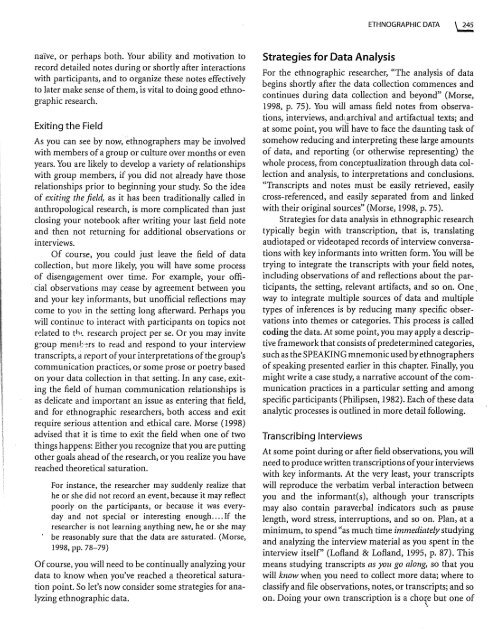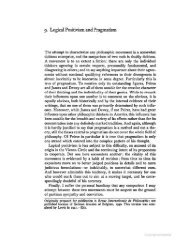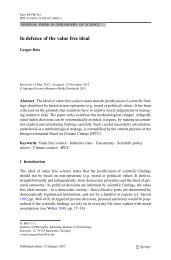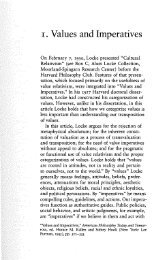Ethnographic Research - Matthew J. Brown
Ethnographic Research - Matthew J. Brown
Ethnographic Research - Matthew J. Brown
- No tags were found...
Create successful ePaper yourself
Turn your PDF publications into a flip-book with our unique Google optimized e-Paper software.
ETHNOGRAPHIC DATA\ 24SnaIve, or perhaps both. Your ability and motivation torecord detailed notes during or shortly after interactionswith participants, and to organize these notes effectivelyto later make sense of them, is vital to doing good ethnographicresearch.Exiting the FieldAs you can see by now, ethnographers may be involvedwith members of a group or culture over months or evenyears. You are likely to develop a variety of relationshipswith group members, if you did not already have thoserelationships prior to beginning your study. So the ideaof exiting the field, as it has been traditionally called inanthropological research, is more complicated than justclosing your notebook after writing your last field noteand then not returning for additional observations orinterviews.Of course, you could just leave the field of datacollection, but more likely, you will have some processof disengagement over time. For example, your officialobservations may cease by agreement between youand your key informants, but unofficial reflections maycome to YOll in the setting long afterward. Perhaps youwill continue to interact with participants on topics notrr~lated to th,. research project per se. Or you may inviteg:.-oup meml.:':'rs to read and respond to your interviewtranscripts, a report of your interpretations of the group'scommunication practices, or some prose or poetry basedon your data collection in that setting. In any case, exitingthe field of human communication relationships isas delicate and important an issue as entering that field,and for ethnographic researchers, both access and exitrequire serious attention and ethical care. Morse (1998)advised that it is time to exit the field when one of twothings happens: Either you recognize that you are puttingother goals ahead of the research, or you realize you havereached theoretical saturation.For instance, the researcher may suddenly realize thathe or she did not record an event, because it may reflectpoorly on the participants, or because it was everydayand not special or interesting enough .... If theresearcher is not learning anything new, he or she maybe reasonably sure that the data are saturated. (Morse,1998, pp. 78-79)Of course, you will need to be continually analyzing yourdata to know when you've reached a theoretical saturationpoint. So let's now consider some strategies for analyzingethnographic data.Strategies for Data AnalysisFor the ethnographic researcher, "The analysis of databegins shortly after the data collection commences andcontinues during data collection and beyond" (Morse,1998, p. 75). You will amass field notes from observations,interviews, and~rchival and artifactual texts; andat some point, you will have to face the daunting task ofsomehow reducing and interpreting these large amountsof data, and reporting (or otherwise representing) thewhole process, from conceptualization through data collectionand analysis, to interpretations and conclusions."Transcripts and notes must be easily retrieved, easilycross-referenced, and easily separated from and linkedwith their original sources" (Morse, 1998, p. 75).Strategies for data analysis in ethnographic researchtypically begin with transcription, that is, translatingaudio taped or videotaped records of interview conversationswith key informants into written form. You will betrying to integrate the transcripts with your field notes,including observations of and reflections about the participants,the setting, relevant artifacts, and so on. One,way to integrate multiple sources of data and multipletypes of inferences is by reducing many specific observationsinto themes or categories. This process is calledcoding the data. At some point, you may apply a descriptiveframework that consists of predetermined categories,such as the SPEAKING mnemonic used by ethnographersof speaking presented earlier in this chapter. Finally, youmight write a case study, a narrative account of the communicationpractices in a particular setting and amongspecific participants (Philipsen, 1982). Each of these dataanalytic processes is outlined in more detail following.Transcribing InterviewsAt some point during or after field observations, you willneed to produce written transcriptions of your interviewswith key informants. At the very least, your transcriptswill reproduce the verbatim verbal interaction betweenyou and the informant(s), although your transcriptsmay also contain paraverbal indicators such as pauselength, word stress, interruptions, and so on. Plan, at aminimum, to spend "as much time immediately studyingand analyzing the interview material as you spent in theinterview itself" (Lofland & Lofland, 1995, p. 87). Thismeans studying transcripts as you go along, so that youwill know when you need to collect more data; where toclassify and file observations, notes, or transcripts; and soon. Doing your own transcription is a chore but one of'.






